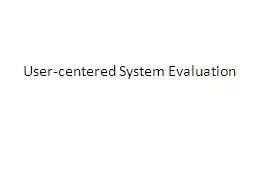PPT-User-centered System Evaluation
Author : liane-varnes | Published Date : 2017-08-13
Reference Diane Kelly 2009 Methods for Evaluating Interactive Information Retrieval Systems with Users Foundations and Trends in Information Retrieval 312 1224 DOI
Presentation Embed Code
Download Presentation
Download Presentation The PPT/PDF document "User-centered System Evaluation" is the property of its rightful owner. Permission is granted to download and print the materials on this website for personal, non-commercial use only, and to display it on your personal computer provided you do not modify the materials and that you retain all copyright notices contained in the materials. By downloading content from our website, you accept the terms of this agreement.
User-centered System Evaluation: Transcript
Download Rules Of Document
"User-centered System Evaluation"The content belongs to its owner. You may download and print it for personal use, without modification, and keep all copyright notices. By downloading, you agree to these terms.
Related Documents














